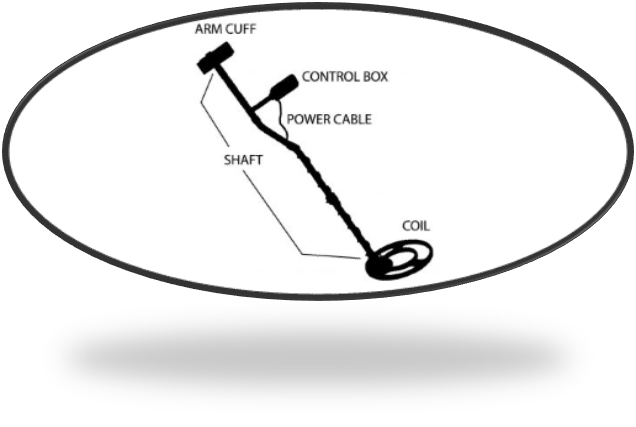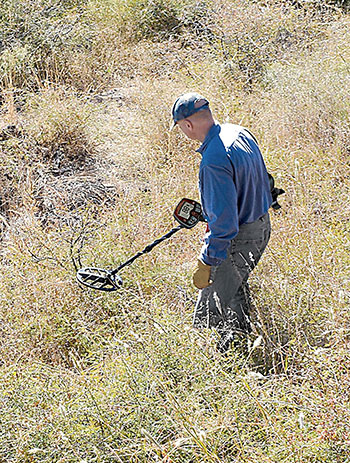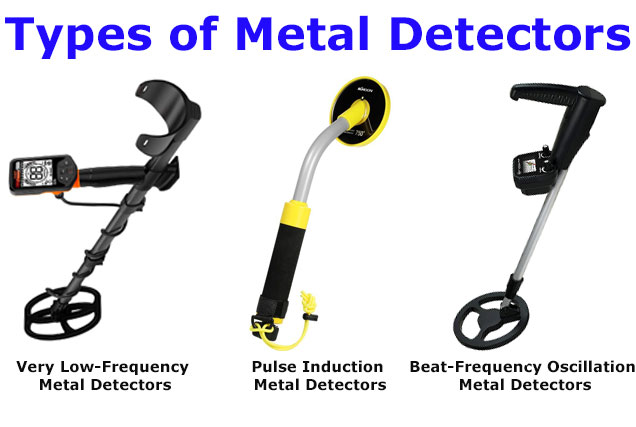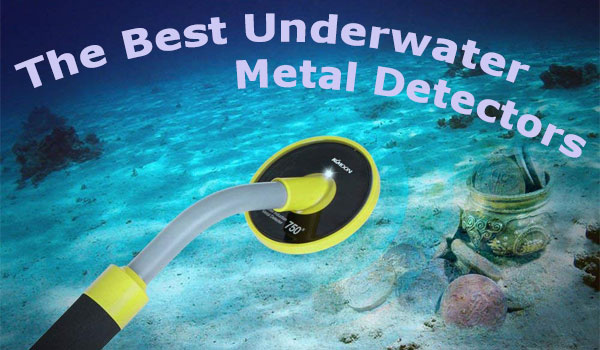A Beginner’s Guide for Metal Detectors
 If you are a treasure hunter or detectorist, you understand that metal detectors are the hunting dogs; they direct you to where the kill is. For that reason, it is the first equipment you want to buy to prospect for metals; whether coins, gold, relics, among other pieces.
If you are a treasure hunter or detectorist, you understand that metal detectors are the hunting dogs; they direct you to where the kill is. For that reason, it is the first equipment you want to buy to prospect for metals; whether coins, gold, relics, among other pieces.
However, just like hunting dogs, you need to understand the basics of metal detectors, how they work, and the different types available and so on. This is the kind of information that will help you rise the ranks from a beginner treasure hunter to an intermediate.
In this article, we want to dwell on metal detectors, strip it down to know the main parts, and the functions. But most importantly, we want to examine the different types of metal detectors and what each class is recommended for.
What is a Metal Detector?
Though metal detectors have mainly been used in military operations, airport security and so on, they are now a favorite tool for treasure hunters.
In the field of treasure hunting, a metal detector is a piece of equipment that is hovered on the ground and gives detectorists signals when it detects any metal compounds.
Examples of metal detectors include Fisher Gold Bug Pro and Garrett AT.
How it works?
The most important thing to know about metal detectors is how they work. The device sends out an AC via the coil. Any metal in the ground will respond to the AC by setting up an Eddy current. Consequently, a B field is formed and directly affects the AC – it is from this change that the device detects metal.
But that is as far as general metal detection is concerned. To filter down specific metals, for instance, gold and silver, there are extra features to do the screening job.
There are different applications of metal detectors; from security to treasure hunting.
Is a metal detector a worthy buy?
Definitely yes, if you want to venture in treasurer hunting, you need to purchase a metal detector. A good beginner metal detector will set you back an average of $500. Indeed it is quite an investment but one that proves to be very fruitful when you lucky star shines.
Here are the top 5 treasures detectorists found with a metal detector.
- 1. The boot of Cortez – In 1989, an Australian man unearthed a 12-inch gold nugget using a beginner metal detector. It sold in 2008 for over $1.5m.
- 2. Antique Gold Chalice – In 2008, Mike DeMar found a golden chalice while diving off Key West. It sold for a whopping $1 million.
- 3. Stolen Poster Money – Postal authorities uncovered over $150,000 in coins taken by one of their deceased employees.
These are a few among the high-value treasures discovered using a metal detector. However, in as much as metal detectors are used to find treasures, they can also lead you to scary discoveries. Take the case of an archaeologist who discovered a ring, but in its skeleton finger where Col. George Custer’s troops were killed in 1876 by the Sioux.
How to use a metal detector
For starters, it is essential to learn the basics of using your metal detector. Your first search is a remarkable event, and you want to have a smooth one lest you lose interest in the new hobby.
To be in the best position of using a metal detector, you need to understand the main parts of the metal detector.
Anatomy of a Metal Detector
A metal detector has very many parts, but the following are what you need to know at a beginner level.

- 1. Arm Cuff – The arm cuff is also known as a stabilizer. It is an optional feature that enables detectorists to comfortably handle the entire unit when swaying the detector back and forth. If you are buying a large detector, or treasure hunting is your full-time hobby, you need to get a device that has a comfortable arm cuff. You will only realize the essence of this feature when doing two hours plus of intensive prospecting.
- 2. Control box – This is the engine of the metal detector and has been enclosed to protect the electrical components inside. In the control box, you will find the main circuitry, motherboard, control panel and LCD if it features one. The type of material used to make the control box is fundamental. It sets apart waterproof from non-waterproof metal detectors.
- 3. Shaft – The shaft is the central extension that links the control box and the coil. It is the frame of the entire unit and might be adjustable for different heights. A wire is spiraled around it from the control box all the way to the coil.
- 4. Wire cable – This is the part that carries the signal from the loop to the control box. Your regular metal detector will come with a wire but advanced models come with wireless technology like Bluetooth instead of all the wire clutter.
- 5. Coil – This is the round attachment at the bottom that is typically leveled with the ground. It is a very crucial part as it sends out the waves that consequently detect the presence of metals.
Types of Metal Detectors
Like earlier mentioned, you will find a range of metal detectors in the market. In this section, we want to discuss the three types of metal detectors that you need to know about as a treasure hunter. This is a very crucial knowledge that you don’t want to miss out on lest you end up with the wrong product.
Very Low-Frequency Metal Detectors (VLF)
VLF metal detectors, also known as induction balance is the most popular metal detection technology. Probably, the regular metal detector you are using is a VLF. The most distinct feature of these metal detectors is two coils, a transmitter, and receiver.
Pulse Induction
This is the best metal detector technology, and Minelabs happens to be one of the best PI metal detector brands. Unlike VLF detectors, PI uses one coil that acts as the transmitter and receiver. If you are prospecting in a highly mineralized field, this is the detector you want to tag along.
Beat Frequency Oscillation
This is the most basic of metal detection technologies and is mostly in the simple metal detectors. So, what exactly happens in Beat Frequency Oscillation? In these detectors, there is one big ring at the bottom and another small one slightly at the top of the shaft. These rings are linked to oscillators that produce a frequency. The detector works on the principle of reading any intrusions in the frequency transmission between the two rings, as simple as that.
Frequency
A ubiquitous term within the ranks of metal detecting is frequency. It is measured in kilohertz and refers to the number of waves per unit of time. In our context, the frequency is the number of electronic waves that a metal detector send to the ground via the coil. To put it into perspective, if your detector is rated 20 kHz, it means it can send and receive 20,000 times per second. When it comes to frequency, I always like to have an in-depth discussion because it is the most critical dynamic in metal detecting. Today, I want to touch on one crucial aspect, types of frequencies.
Low frequencies are best in prospecting for high conductivity metals like silver. That is why the best coin metal detectors are low frequency. Low frequencies have longer wavelengths that enable them to go deeper in the ground. Unfortunately, they are not ideal for small targets.
High frequencies, on the other hand, are best for low conductivity metals like iron and gold. These are short wavelengths and wouldn’t go as deep as low frequencies. That said, the high-frequency detectors are best for upper surface detecting only. The best thing it that is has high accuracy and will find tiny gold nuggets even in mineralized grounds.
So, what’s the best frequency? I will tell you that there is no such thing as the best metal detector frequency. The truth of the matter is that every frequency is designated for a particular subset of treasure hunters. What you need to do is pick the right frequency type for the job.
Ground Balance
More often, you will hear the word ground balance being used, so it’s important to know the meaning. You will agree with me that in any ground sample, there are very small mineral irons included. These materials are what we call non-target material and will significantly affect your prospecting missions.
Ground balance refers to an equilibrium where the detector is set to ignore this non-target material. Ground balance works the same way as noise isolation in speakers. While Ground balance is all about suppressing the non-target materials, noise-cancellation contains the background noise.
So, what’s the difference and what suits you best?
Manual ground balance as the name suggests is a manual adjustment. It could be troublesome finding the right setting, so you want to use an automatic ground balance adjustment. Here, the settings are automatically adjusted, and it is much more accurate.
Lastly, we have tracking ground balance which is an on the go mode that will adjust the ground balance as it works. This is the best ground balance setting as it is always precise at every point it is.
Discrimination
What if your prospects are not interested in other metals?
There is a feature called discrimination that helps detectorists to filter out any metals considered junk.
Variable metal detectors allow users to adjust the desired discrimination level. This is an elementary function especially if you work in highly mineralized fields. Then we have notch metal detectors, and these are the best because they allow you to filter out specific subsets of metals. Ideally, you can choose to prospect for certain metals only or shield out particular metals.
Last, there’s what we call iron reject which is as pretty straightforward as the name. This discrimination shields iron junk only.
Using a Metal Detector
Now that we know about the main parts of a treasure hunter’s metal detector, it’s time we look at how it works.

So, how do you bed-test your metal detector coil? Dig three holes, 3, 5, and 10 inches deep and bury the coin first. Cover the hole and try detecting above the ground, noting the difference in sound at a different setting. Try the coin again at different inclinations recording the observations. You want to do this with as many items to give you a good understanding of the frequency as well as usability of the metal detector. Do this research extensively, and after you feel you have passed the test, you are ready for your first serious treasure hunt.
The first thing to do when you are on the site is to put the device on. Then, hover the coil close to the ground but don’t let it touch down. Sway it over the area in a back and forth motion slowly, while listening for any response.
If you hear any sound or sort of sound distortion, then know you are above something. You are almost finding your first relic. Now, depending on the model you are using, you can get to see the type of metal you have found and its location.
In some advanced models, you can filter the minerals you are interested in or search for just any metal. These are just among the features you will find, but we will look at them in detail later on.
Metal Detecting Tips
- 1. Buy the right metal detector depending on what you are prospecting for, and most importantly, where? Many beginners out there are using the wrong tool on the wrong job.
- 2. Decide your hunting ground wisely. A lot of people end up blaming the metal detector yet they were detecting in an impotent ground.
- 3. The first thing you want to do is wear the appropriate gear when out treasure hunting. Of importance is a pair of gloves when you are looking for the target in the muck.
- 4. Never dig out anything you deem dangerous. Most of the relics are weapons, including bombs which may be active. Notify the authorities in case of any other unusual finds that you think are dangerous.
- 5. Go hunting with a buddy. Treasure hunting can be boring, so a company would make it easier. Also, two minds are better than one during such adventures.
How Far will a Metal Detector Go?
This is a ubiquitous question amongst newbies but a very reasonable one. You want to know what device will be ideal for deep relics and what can handle shallow remnants.
There is no definite answer to this question but what I can tell you as a simple rule is, your metal detector a depth the same as the coil’s diameter, That said, you want to focus on the diameter size of the detector’s coil, but that’s a story for another day.
Besides the coil’s diameter, several other factors will influence the working depth of a metal detector. So, don’t be surprised when you find something deeper or when your device didn’t discover a shallow relic.
So, what exactly are you looking at here?
The level of ground mineralization is the first explanation for varied metal detector working depth. Typically, a target in a highly mineralized site will not be easily detected. On the other hand, a target in a lowly mineralized area will be found even if it is much deeper.
The other reason now regards the target itself, and here, many factors come into the picture. First is the conductivity where a highly conductive material can be detected deeper than low conductive materials. The size also matters, and you will find that larger relics are easier to discover even when deep in the earth than small relics. The shape and orientation also play a part. Targets with a larger surface area more visible than small surfaced relics. How they are positioned also matter with better visibility when a larger size is facing upwards.
Buying the Right Metal Detector
Before we wind up this article, it is essential to look at a few things regarding purchasing the right metal detector.
So, what should guide you when purchasing a metal detector? The biggest question that should be on your mind is, what is your experience level? Then, where are you taking your prospecting? Is it in the waters, the beach or land? Also, what are you prospecting for? With these questions, you will end up with several categories of metal detectors; land, underwater, beach, and gold and coins detectors. You will also find beginner, intermediate, and expert metal detectors.
Kids vs. Beginner vs. Intermediate vs. Expert Metal Detectors
Metal detectors have been designed to suit different skill levels. The first category is for kids, and this consists of very lightweight and basic metal detectors. The prices range from $50 – $100 and may find a range of treasures as long as you are on the right site. There are also beginner metal detectors which have easy usability to suit amateurs. Once you learn the basic of metal detecting and you feel you are ready to take it to the next level, you need an intermediate metal detector.
Land vs. Underwater Metal Detectors
As the names suggest, these are metal detectors that are designed to prospect for treasure on land and water respectively. This is the most important thing to distinguish between when buying metal detectors, especially for underwater exploration.
I know you are wondering what all the fuss is about yet you are prospecting for the same thing. The truth of the matter is that land metal detectors are not designed for underwater hunting. In as much as you might have made it underwater with one and it came out alive, there is more than meets the eye.
By design, the control box, as well as the coil, is made to be waterproof if it is for underwater use. Most of the land detectors are not waterproof, and thus you risk damaging your treasure hunter. Worse enough, you are exposing yourself to risk by getting inside water with an electrical component that is not meant for water.
However, the biggest problem is salty water. If you happen to have combed salt water with a land metal detector, you understand the disappointment of the many wrong signals. In water, there are rocks, and all kinds of minerals and salty water magnifies these ground minerals consequently affecting your signal.
Gold, Coins and Beach Metal Detectors
You will also hear of metal detectors for gold, and these are designed to detect gold. They can detect small nuggets to large pieces from the shallow surface mines to deep inside the earth.
One characteristic of a suitable metal detector for gold is the frequency. An example is Fisher Gold Bug 2 that is rated at a whopping 71 kHz. But note that high frequency is not always the best in all cases. At times, you need low frequencies to go deeper.
Ancient coins are also a common treasure, and there are also specific metal detectors designed for coins. However, most of them are just the same that you would use to prospect for gold as most treasure coins are made from gold, silver, and other precious metals.
Beach treasure hunting also requires specific metal detectors, and I will tell you one property. It needs to have ground balance as well because beaches are also highly mineralized fields.
Metal Detecting Etiquette
The first thing I want to talk about is regarding environmental conservation. While digging up whatever relics you find, try as much as possible to do so with minimal ground disturbance. A right way is to use a pinpointer to get more accurate locations of the targets.
The second thing is regarding timing. You don’t want to go hunting when everyone is busy all over the place. Go to beaches very late or very early when there is no human traffic. Also, it is imperative that you be polite as you will meet different kinds of people. In case anyone inquires about what you are doing, tell them the truth politely. If you face any hostility, it would be a wise idea to leave rather than argue.
What is the best place to buy a metal detector?

The local stores are a great choice if you want a detector urgently; no orders, no confirmations or delivery waiting time. You also get to feel the actual product, something pictures and videos won’t substitute. But then, it is rare to find variety at your local store, and that’s where online stores come in.
Wrapping Up
There you have it, folks, a complete beginners guide to metal detecting.
Make sure to read more books, watch videos and read a lot about metal detectors. Join metal detecting forums too and discuss experiences; other detectorists opinion might help you realize your first treasure.
Above all, make sure you buy the best metal detector and always, abide by the metal detecting etiquette!



